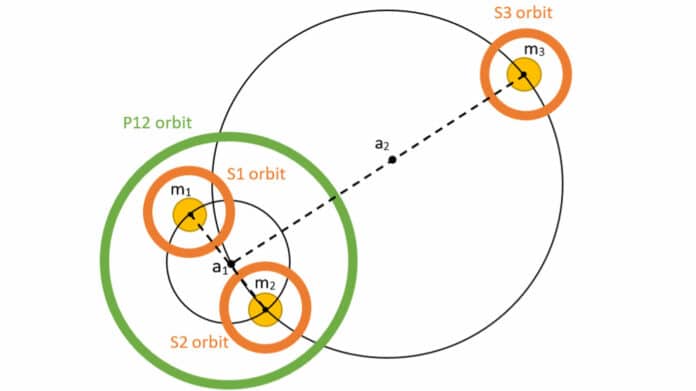Single stars host most planets, although a notable number of planets are members of stellar binary systems. However, the number of planets found to be hosted by higher-order systems is relatively small, i.e., about 40 for triple and quadruple systems combined, with the exact number depending on whether some controversial or unconfirmed cases are included.
A new study focuses on this kind of system. A study that lists all known triple-stellar systems—those with three or more stars with planets—that are known to contain planets is led by a planetary physicist from The University of Texas at Arlington. The study offers a thorough bibliographic assessment of planet-hosting, triple-stellar systems.
The research provides a system classification that considers, among other things, different planetary orbital characteristics. The authors also look at historical debates and planet retractions based on the definition of a triple-stellar system that hosts planets.
Each of the two subgroups that make up triple-stellar systems orbits the system’s mass in a relatively wide orbit. In a triple-star system, two stars typically form a tight binary pair (two stars gravitationally connected to and in orbit around one another), and the third orbits the pair from a further distance. Systems with more than three stars are anticipated to result in even more intricate orbital configurations.
Manfred Cuntz, professor of physics, who led the project, said, “The number of confirmed planets in triple-stellar systems currently stands at about 30, approximately 0.5% of the total number of planets identified. This aspect makes those planets very special.”
“The NASA Kepler Space Telescope, operational from 2009-18, aided in discovering planet-hosting, triple-stellar systems.”
Scientists noted, “The overwhelming majority of triple-stellar system planets are Jupiter-type, meaning they are gas giants, and the host stars are relatively massive, compared to typical main-sequence stars. However, some Earth-mass planets have been found as well.”
Cuntz said, “The existence of planets in triple-star systems is extremely challenging theoretically, both regarding their formation and orbital stability. These topics are a stark motivation for future UTA research, also involving students.”
Journal Reference:
- M. Cuntz, G. E. Luke, et al. An Early Catalog of Planet-hosting Multiple-star Systems of Order Three and Higher. The Astrophysical Journal. DOI: 10.3847/1538-4365/ac9302
